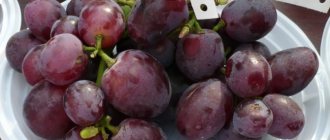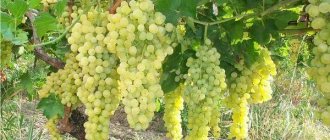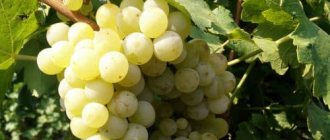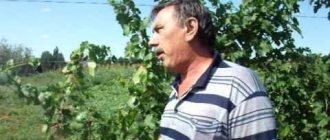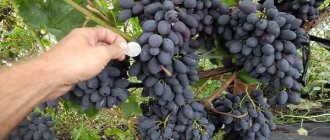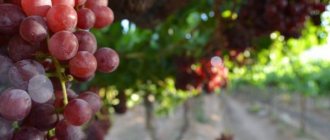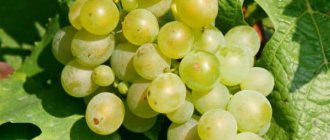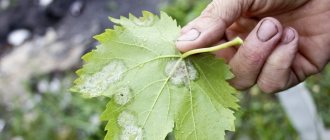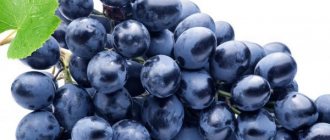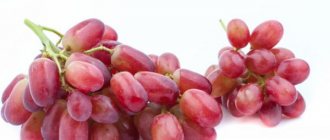History of selection and region of breeding
The Druzhba variety is the joint brainchild of Russian breeders VNIIViV named after. Potapenko and Bulgarian winegrowers NIIViVa. The varieties Villan blanc, Misket Kailyshki and Muscat Hamburg were taken as parent forms. After appropriate tests, the new variety was recommended for cultivation in different regions of Russia, although in the northern parts, with more severe winters, it will have to be covered. This grape was included in the State Register of Breeding Achievements in 2002.
Did you know? One of the oldest vineyards in the world is located in Slovenia, in the city of Maribor. It is there that grape bushes grow, about 400 years old, from which the raw materials for 100 small bottles of wine are obtained annually.
Planting and care
Planting in a trench
When planting grapes, you should follow the recommendations: prepare planting holes in the fall, plant seedlings in the spring, the optimal time for planting seedlings is the end of March - the beginning of April. The soil will freeze over the winter, reducing the number of pests and pathogens in it.
Grapes are a southern crop, so they prefer light soils: sandy, loamy, sandy loam. Close groundwater and grapes are not compatible. The central root of an adult bush goes to great depths. Groundwater can destroy the bush.
The planting site is chosen on the sunny side, preferably on the south side of the site. The hole is dug large and deep. The shape of the pit does not matter, the main thing is to maintain its width - 70 cm and depth - 70 cm. The first layer in the hole is poured with drainage - medium-sized crushed stone. The thickness of the layer is 15 cm. Next comes a layer of garden soil, filled with humus (1 bucket), ash (1 l), mineral fertilizers: superphosphate (200 g), potassium nitrate (150 g).
Before planting the seedling, a cone is formed in the center of the hole from earth mixed with humus. The roots of the seedling are distributed around the cone, watered with water (from 2 liters to 2 buckets) and densely covered with soil, tamping each layer (10-15 cm). It is important to correctly position the seedling to the parts of the world: the root heel should face south, the buds should face north. Water the top of the hole if the soil is too dry. The tree trunk circle is covered with mulch.
Care
Gartering the vine
Care consists of watering and fertilizing. Watering is carried out according to the weather, focusing on soil moisture. At least 20 liters of water are consumed per watering. To retain moisture, the soil between the rows is mulched. Loosening the tree trunk improves oxygen access to the roots. By destroying weeds, they protect Druzhba grapes from diseases and pests.
Don't forget about fertilizing. During the summer, feed the grape bush at least 3 times. The first application of fertilizers is carried out in the spring, until the grapes have gained color. At this time, chicken manure and fertilizers containing phosphorus (superphosphate) are added. The second feeding is carried out after 10-14 days, the third - at the beginning of fruiting. Use nitroammophoska.
The bushes need pruning. Up to 3 years, sanitary pruning is carried out, removing dry and damaged shoots. Starting from 3 years, formative pruning is carried out annually. Leave 6 to 8 buds on the fruiting shoot, based on the required load on the bush of 35 buds. The bushes are tied to a trellis. The trellis is constructed with a height of at least 2 m.
Frost protection
Shelter from frost
The frost resistance of the bush (eyes, shoots) is good, but in a temperate climate the bushes need to be prepared for winter in a timely manner. Young (annual) Druzhba grape bushes spud. Mature bushes are covered completely or partially. Early covering of the vine is not recommended; it can provoke the formation of eyes.
Close the bushes on the eve of frost or immediately after it. Just before the frost, the last moisture-recharging watering is carried out. It helps protect grape roots from freezing. For covering, use any type of non-woven covering material folded in several layers, spruce branches, reed and straw mats. In winter they are covered in snow. In spring, young bushes are raked. All covering material is removed from adult bushes.
Disease Prevention
Spraying with biofungicide
During the season, protective preventive measures are carried out against mildew and gray rot. The bushes are treated 2 times against mildew. Drug solutions used:
- Abiga Peak;
- Cuprosan;
- copper oxychloride;
- Bordeaux mixture.
Treatments against gray rot and oidium are carried out in early spring and autumn after complete harvesting. Drugs used:
- Mikal;
- Sandofan;
- M-8;
- Byleton;
- Rovral.
Clean row spacing and tree trunk circles reduce the incidence of grape bushes. The health of the bush is preserved by timely harvesting, cleaning the bushes from damaged shoots and spoiled berries.
Description and characteristics of the Druzhba grape variety
Upon careful study of the appearance and productive characteristics of the Druzhba grapes, it is easy to notice that the variety has a considerable number of advantages, which are primarily expressed in a fairly high yield and taste characteristics of the berries.
Description of berries
A cylindrical bunch of grapes consists of medium-sized round berries. Each of them has a mass of 4 g, with a diameter of no more than 2 cm. The color of the fruit is amber-green, with slightly whitish tints, which are clearly visible under the sun's rays. The skin is thin, but quite dense, thanks to which the variety tolerates transportation well. The pulp hidden underneath is fleshy and at the same time juicy, which only enhances the taste characteristics of the grapes. At the end of the ripening period (approximately September), the sugar content of the fruit reaches 19–21%, and the acidity ranges from 6.5–7.5 g/l.
Taste characteristics
The taste of the fleshy and very juicy pulp can be called harmonious, because the berries of the Druzhba grapes combine delicate sweet notes with subtle sourness and a delicate muscat smell. The skin on the fruit is relatively thin, so it is practically not noticeable when eating grapes.
Important! Despite its high taste properties, the grape bunches of the Druzhba variety are not large in size, which is why the plant is not often planted for sale in spontaneous markets. More attractive in this regard will be the Red Honey or Arcadia varieties, the weight of the brushes often reaches 1–2 kg.
Productivity
The described variety belongs to the early ripening varieties, so in the regions of the middle zone the first harvest can be collected in mid- or late August. If the shoots are overloaded with grape clusters, then the berries ripen a little later, especially if the plant grows in the northern regions. Each bush shows fairly high yields, which on average reaches 60–80%. In general, during the entire growing season, at least 150–180 centners of fruit can be collected from 1 hectare. The weight of one bunch is 300–350 g.
Disease resistance
Compared to other popular grape varieties, Druzhba actually has good resistance to fungal diseases, in particular downy mildew and mildew, which are more common on plants than other diseases. However, in some regions the likelihood of developing these diseases is still high, which is why experienced winegrowers recommend treating grape bushes with appropriate chemicals, for example, Polyram.
Frost resistance
Grapes of this variety can overwinter without shelter, but this is only if the temperature outside does not drop below –23…–24°C. Further decline will most likely cause the vine to crack, which will prevent the shoots from producing a good harvest next year. Winegrowers in the central regions of Russia, Belarus and Ukraine should not worry about this, but gardeners in the northern territories would still be better off taking care of appropriate shelter for the bushes for the winter.
Did you know? Among the most expensive grape varieties, one cannot help but highlight the Japanese variety Ruby Roman, for one bunch of which wealthy people shelled out more than $8,000.
Application of grapes
Many winegrowers, not without reason, consider the Druzhba variety to be the real standard of Muscat, which determines the area of use of grape fruits. This is a truly universal variety that has good table-technical qualities. Thanks to this, grape bunches are excellent for both fresh use and for the preparation of high-quality Muscat drinks: wines (dessert and table varieties), sparkling champagne. Tasters rate the resulting wine quite high: 8.6 points for the dry variety and at least 9.4 points for the sparkling champagne. In addition, if you believe the reviews of summer residents, Druzhba grapes can make good juice, which, if desired, can be sealed in jars.
Positive and negative traits
Despite the small berries and small clusters, the Druzhba grape variety has many positive characteristics:
- resistance to fungal diseases;
- early ripening of the crop;
- vine resistance to low temperatures;
- excellent nutmeg taste of berries;
- universal purpose of fruits.
The disadvantage is the difficulty of care due to the mandatory normalization of the eyes. The bunches are not in demand for sale. The grapes are tasty, but small berries and loose clusters do not create a good presentation.
Advantages and disadvantages of Druzhba grapes
- Speaking about the advantages of the variety, first of all it is worth remembering the following qualities:
- early ripening;
- high resistance to diseases and pests;
- good nutmeg taste.
In addition, there is also a reduced interest on the part of wasps, due to which most of the crop remains undamaged by these insects. As for the disadvantages of growing the described grapes, we cannot help but mention the relatively small bunches and the need for shelter for the winter in certain regions.
Characteristics
- The variety is characterized by average yields (up to 150-170 centners). The quality of the harvest can be improved through proper and regular care. Pay more attention to watering, proper planting and replanting, regular pruning and fertilizing, disease prevention;
- Please note that often a lot of eyes are formed on one bush. Although the branches of the grapes are strong and can withstand a fairly large volume, such a number of berries simply will not ripen, especially in the climate of our region. The optimal load on the bush is 30 eyes (no more than 35);
- The frost resistance of the variety is high. Bushes can withstand up to -20 -23 degrees in winter. At the same time, remember that grapes are a heat-loving crop and need additional shelter in winter.
Studies of winegrowers indicate that over the past few years, more bushes have died from sudden temperature changes than from diseases, pests, and even from locust attacks;For this variety it is recommended to use full cover with long pruning. Partial cover does not adequately protect the plant.
- An experienced gardener needs to know that the variety has good affinity with the rootstocks Chasselas x Berlandieri 41 B, Berlandieri x Riparia Kober 5 BB.
Among the frost-resistant varieties, it is worth noting Pink Flamingo, Super Extra and Beauty of the North.
Growing in open ground and in a greenhouse
Wherever you are going to grow Druzhba grapes, in any place this process will have common characteristic features of planting and further care. In order not to make mistakes in the actions performed, it is important to study their detailed description.
Important! The procedure for covering grapes should be carried out no earlier than 2-3 weeks before the expected frost, otherwise the prematurely covered plant will rot or unnecessary eyes will appear on it.
Planting seedlings
Having decided to plant a grape seedling on your plot, first of all you should pay due attention to choosing a suitable place. In the case of the described variety, the level of illumination and relatively high temperature play a big role in this issue, but the composition of the soil will not be so important. The main requirement for soil is good water permeability (without stagnation of moisture).
If the possibility of stagnation still exists, then you will have to take care of a good drainage layer in the planting hole. Its preparation for planting, as well as the preparation of the entire site, is carried out according to the generally accepted scheme: in the fall, you need to remove all plant debris from the site, dig a hole measuring 70x70x70 and lay a drainage layer about 15 cm thick on the bottom.
In addition, in the autumn it is useful to put fertilizer in the hole, prepared from a small amount of dug up soil, 1 bucket of humus, 1 liter of ash, 200 g of superphosphate and 150 g of potassium nitrate. During the winter, all these substances should be well absorbed into the ground, and with the arrival of spring, all that remains is to add clean soil to the hole, occupying approximately 1/3 of the depth of the hole.
A day before the intended planting of the Druzhba grape seedling, it needs to be inspected again and withered or broken roots removed. If possible, you can dip the rhizome into the Kornevin solution, which will speed up the process of adaptation of the seedling to a new location. The further planting process consists of the following steps.
- Pour a small amount of soil into the previously prepared hole, but so that a small hill forms at the top of the embankment.
- Place the seedling on a hill and carefully straighten its roots.
- Based on the quality of the soil mixture used, add about 1 bucket of water to the hole, fill it with soil and lightly compact the soil.
- Mulch the soil around the trunk with peat or manure.
To prevent the grapes from breaking and begin to actively grow, it is useful to tie them to a support, which must be placed at a distance of 30–40 cm from the trunk of the seedling. When growing several grape bushes at once, the next plant should be planted no closer than 1.5 m from the previous one.
Video: planting grape seedlings
Agricultural technology
To protect against wasps, mesh bags are placed on the hands.
Winegrowers who have been dealing with this variety for many years recommend carefully monitoring how the variety behaves in your specific conditions.
The ripening of shoots is determined at the level of 85% , the bush produces fruitful shoots at 70–80% . The load of bunches per shoot is in the range of 1.1–1.5 .
The planting area is sufficient within 2.5 x 2.5 m .
Trimming
The recommended standard is two brushes per shoot.
The opinions of winegrowers were also divided on how to prune, since everything very much depends on climatic and agrotechnical conditions.
- Some winegrowers prune by 2 buds and no more , and are satisfied with the result.
- Others cut it by 5-6 and are just as happy.
Everything is very ambiguous. To determine your optimum you need to try this way and that.
Propagation by cuttings
Another peculiarity of agricultural technology of this variety is propagation by cuttings. Reviews indicate that it gives a low rooting yield of cuttings.
When purchasing several pipes, you need to be prepared for the fact that only half of them will take root. This will happen if rooting is carried out correctly.
At the same time, winegrowers willingly share information that rooting agents such as “Kornevin” perfectly bring the percentage to 70.
Features of caring for the variety
Immediately after planting, it is better to leave the seedling alone for a while, because the moisture and nutrients that were added to the soil earlier should be enough for it to quickly adapt to a new place. After a week, when the soil has dried well, you can repeat the watering, using at least 2 buckets of settled water for each bush. After it is absorbed, be sure to loosen the soil in the tree trunk circle and remove weeds. The regularity of subsequent watering is determined based on the condition of the soil.
Find out more about how to properly feed grapes in the fall.
It is advisable to apply fertilizers for the Druzhba variety to the soil at least 3 times a season:
- In the spring, before flowering begins, the plant needs to be fed with a mixture of chicken droppings and superphosphate (take 60 g of rotted droppings and 20 g of superphosphate per 10 liters of water).
- A week and a half after the previous fertilizing, add Nitroammofoska to the soil along with watering.
- With the beginning of fruiting, either use Nitroammofoska again, or choose another fertilizer, but always with a high content of phosphorus and potassium.
As for pruning the vine, in the first 3 years it is only of a sanitary nature, that is, all dried and damaged branches must be removed from the bush. Starting from the 4th year after transplantation, you can move on to formative pruning so that no more than 35 buds remain on the bush, that is, 6–8 buds should remain on one shoot. To tie up grape vines, a 2-meter trellis is usually used, which will allow you to move the fastening as the shoots grow.
Pest and disease control
The Druzhba variety resists fungal diseases and gray rot well, but no one has canceled prevention. During an epidemic, even a strong immune system cannot resist bacteria. There are a number of important rules aimed at preventing grape diseases:
- The Druzhba grape variety must be sprayed against mildew twice a season. It is optimal to use fungicides that additionally protect against the spread of oidium.
- Regular watering should not lead to waterlogging of the soil. Excess moisture in the heat promotes the development of fungus.
- Regular pruning should be aimed not only at the formation of a bush. Remove vines with visible damage and dry shoots. When rot spreads in summer, cut off the affected shoots.
- In autumn, dry leaves, berries and fallen small branches should not be left under the grape bushes. Over the summer, many harmful microorganisms and pests have accumulated here. Everything from under the grape bushes is raked out and burned.
- During the season, constant maintenance of the soil near the bushes is required. Be sure to carry out loosening, weeding, and mulching. After harvesting, the soil is dug up onto the bayonet of a shovel.
- The main pest for any grapes is wasps. The Druzhba variety is sugary, which greatly attracts insects. Bottle traps help control wasps. If possible, destroy wasp nests. You can spray the berries with special preparations, but eating chemicals is not healthy.
Sometimes winegrowers practice immersing grapes in gauze bags. The method is effective if the material does not touch the berries. Otherwise, the wasps will suck the juice from the berries through the gauze.
Collection and use of fruits
Druzhba grapes are harvested at the end of August (in cool regions - in September). Shelf life is about a month, but only in cool conditions (up to 8 degrees). The fruits are processed into wine, preserves and juices are prepared, and they are sent to the freezer. Desserts, pastries, and berry marmalade are also very popular among housewives.
Friendship is a variety that has been tested by many gardeners and received excellent recommendations. The unpretentiousness of the bushes, high yields, and excellent taste have long become the hallmark of grapes. Despite the abundance of varieties, it is this species that beginners and experienced gardeners continue to prefer.
Properties of berries
The fruits of the Druzhba grapes are a combination of taste and persistent muscat aroma. In terms of the content of useful substances, the berries are leaders among the extensive grape family.
How to get rid of a wasp's nest in the country - folk methods and remedies
Tasting characteristics
The taste of the fruits of Friendship is a combination of pleasant sourness and sweetness. Grapes are considered to be an analogue of nutmeg. The sugar content of ripened berries is more than 20%.
Vitamin content
Thanks to the increased content of vitamins, Friendship is boldly placed among the leaders. The saturation of useful elements significantly exceeds the beneficial qualities of other table varieties.

